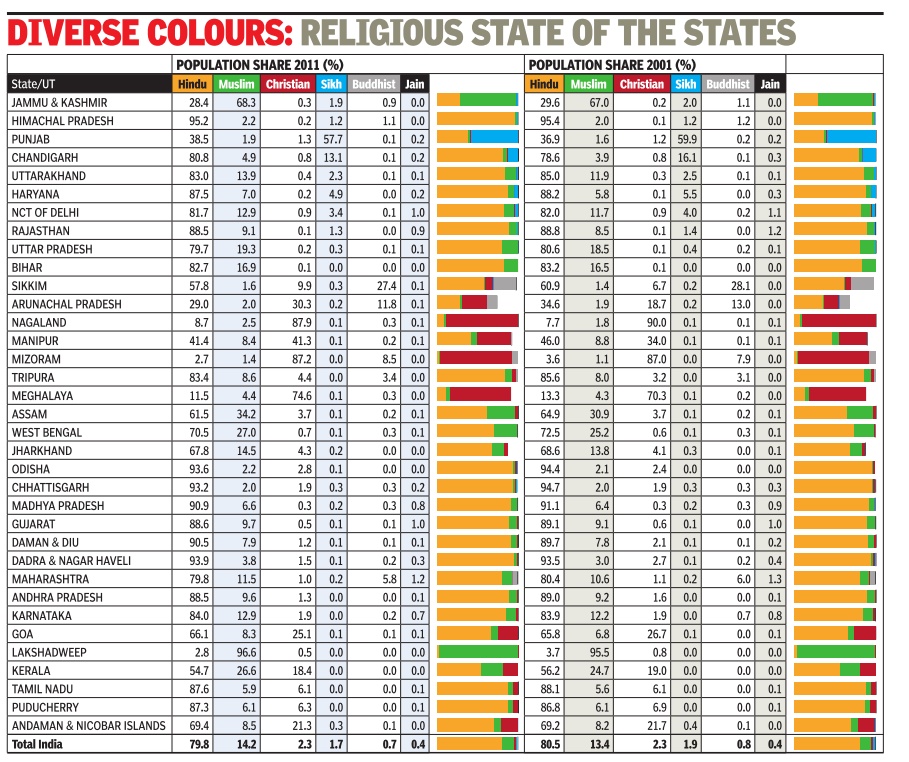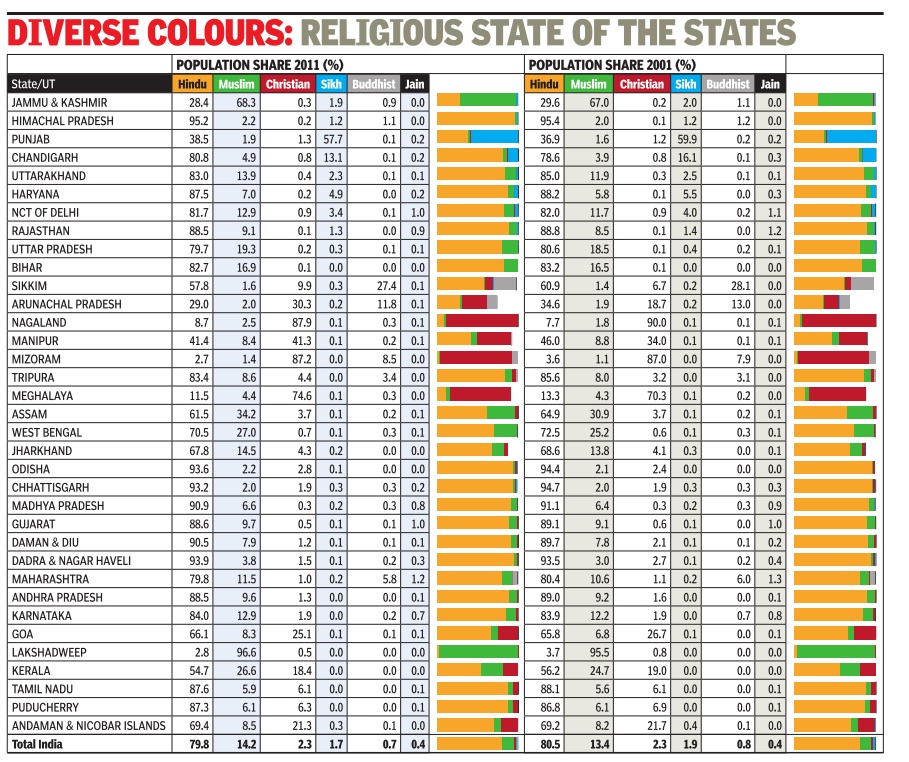Religion-wise demographics: India, after 2001
(→Indians with no faith) |
|||
| Line 61: | Line 61: | ||
Sivakumar B | Sivakumar B | ||
| − | '''2.87 million Indians have no faith, census reveals | + | '''2.87 million Indians have no faith, census reveals''' |
| | ||
| + | |||
India has 2.87 mil ion people who have no aith in any religion -0.24% of the country's population of 1.21 billion -according o the 2011 census, which was the first to include a `non aith' category . The figure includes atheists, rationalists as well as those not interested n any religion but believe in some `unknown' force. | India has 2.87 mil ion people who have no aith in any religion -0.24% of the country's population of 1.21 billion -according o the 2011 census, which was the first to include a `non aith' category . The figure includes atheists, rationalists as well as those not interested n any religion but believe in some `unknown' force. | ||
A majority of people 1,643,640) who ticked the non aith category live in rural areas as compared to those in urban areas (1,223,663). More males (1,463,712) than females 1,403,591) said that they did not believe in any faith. | A majority of people 1,643,640) who ticked the non aith category live in rural areas as compared to those in urban areas (1,223,663). More males (1,463,712) than females 1,403,591) said that they did not believe in any faith. | ||
Revision as of 17:57, 28 August 2015
This is a collection of articles archived for the excellence of their content. |
The religious demographics of India: 2011

The Times of India, Aug 26 2015
Bharti Jain In 10 Yrs, Muslims Grew By 24.6%, Hindus 16.8% The Muslim population grew by 24.6% between 2001 and the 2011 Census, against the 16.8% decadal growth rate of Hindus in the same period. Though the all-India decadal growth of Muslims was less than 29.3% between 1991 and 2001, their statewise decadal growth rate, as reflected in the 2011 Census, is higher than Hindus in all 35 states and UTs.
The 2001-11 growth rate of total population was 17.7%.Christians, during this period, grew by 15.5%, Sikhs by 8.4%, Jains by 5.4% and Buddhists by 6.1%. Those stating other religions and persuasions grew by 19.6% in the 10 years preceding 2011.
Significantly, the number who didn't state their religion went up by 294% between 2001 and 2011.
The stateUT figures for decadal growth between 2001 and 2011 show a notable rise in the Hindu population of UP (24.6%), Jharkhand (21.1%), Rajasthan (20.9%), MP (20%), Puducherry (28.9%) and NCT of Delhi (20.7%). States that show a Hindu decadal growth less than the national average are Kerala (2.2%), Arunachal (5.8%), Bengal (10.8%), Assam (10.9%), Andhra (10.3%), Himachal (12.6%), Odisha (13.2%), Chhattisgarh (13.2%), TN (14.9%), Maharasthra (15.2%), Karnataka (15.8%) and Haryana (16%), among others. Lakshadweep and Mizoram recorded a negative decadal growth at -19.5% and -4.5%. This could be due to their low population base.
States and UTs where the Hindu decadal growth was higher than their averages are Punjab, Karnataka, Goa, Puducherry , Chandigarh, Nagaland, Daman & Diu and Dadra & Nagar Haveli.
Muslims, on the other hand, rose across states, bet tering their national average in Mizoram (46.9%), Haryana (45.7%), Chandigarh (44.7%), Punjab (40.2%), Nagaland (39.9%), Uttarakhand (39%) and the NCT of Delhi (33%), Rajasthan (29.8%), Assam (29.6%), Bihar (28%) and Gujarat (27.3%). Kerala returned interesting results with a 12.8% rise in Muslim population between 2001 and 2011, far higher than the corresponding figures for Hindus (2.2%) and Christians (1.4%).
The decadal growth rate for Christians (2001-11) was higher than 100% in Bihar and Arunachal, but the community recorded a negative growth in five states, including Nagaland (-2.8%), Andhra (-4.4%), Lakshadweep, Daman & Diu and Dadra & Nagar Haveli.
Sikhs recorded a high decadal growth in Odisha (25.7%), Gujarat (27.8%), Andhra (29.8%), Kerala (38.1%) and TN (53%), among others. The community showed negative growth in eight statesUTs.
Jains have shown a 5.4% decadal growth across the country . While Himachal shows a notable growth rate for the community between 2001 and 2011 (28.2%), as many as 8 states recorded a negative growth rate.
2011: Religious minorities more urban than rural
The Times of India, Aug 26 2015

More religious minorities live in urban areas than rural
Subodh Varma Religious minorities in In dia -with the exception of Sikhs -live more in urban areas than rural. This trend existed in previous Census findings too but it appears to have outpaced the general trend of urbanization between 2001 and 2011, according to the Census 2011 data on religious communities released on Tuesday . While only 29% of Hindus live in urban areas, 40% of Muslims and Christians and a whopping 80% of Jains live in towns and cities. Over 43% of Buddhists, a large share of whom are converts from Dalit communities, live in urban areas. Sikhs, on the other hand, with extensive land holdings in Punjab are still largely a rural community , with only 28% of them living in urban areas. A mere 9% of other religious communities live in urban centers. Although details of smaller minority groups have not been released yet, Parsis are large Source: Census 2011, 2001 ly concentrated in urban areas of Maharashtra and Gujarat. Other communities in this category include communities with animist and other tribal beliefs, many of which live in remote areas in the Northeast. Over 77% of the country's Buddhists live in Maharashtra -the heartland of Dalit conversion to Buddhism at the call of Dr Bhimrao Ambedkar. Almost half of this population resides in urban areas.
Urban India's population inched up from 28% in 2001 to 31% in 2011. Urban Hindu population followed this trend, increasing from 26% to 29%. But Muslim urban population rose from 36% to 40% and Christian urban dwellers increased from 34% to 40%.
In some states, such as Gujarat, the jump in Muslim urban population is significantly higher than others -from 59% in 2001 to over 65% in 2011. This migration to towns and cities could be linked with the 2002 communal conflagration in the state and the desire for security .
In Maharashtra, urban share of the Muslim population continues to be high at 73%, up from 70% in 2001. In West Bengal, which has the largest Muslim population in any state, the share of Muslims staying in urban areas was 22% up from 17%.
In another high Muslim population state Assam, only 8% of the Muslims stayed in towns and cities, but that follows the low urbanization rate of just 14% in the state.
Indians with no faith
The Times of India, Aug 27 2015
Sivakumar B
2.87 million Indians have no faith, census reveals
India has 2.87 mil ion people who have no aith in any religion -0.24% of the country's population of 1.21 billion -according o the 2011 census, which was the first to include a `non aith' category . The figure includes atheists, rationalists as well as those not interested n any religion but believe in some `unknown' force. A majority of people 1,643,640) who ticked the non aith category live in rural areas as compared to those in urban areas (1,223,663). More males (1,463,712) than females 1,403,591) said that they did not believe in any faith.
Uttar Pradesh accounts or the most people registered as `non-faith' (582,000) than any other state. Bihar, Bengal, Andhra Pradesh, Telangana, Karnataka and Tamil Nadu all have more than one akh people in the category .
TN, perhaps more than any other state, has a history of atheism. It started with E V Ramasamy (1879-1973), popularly known as Periyar, who propagated atheism (or rationalism) in the early 1900s. Since then, the political party he founded, Dravidar Kazhagam, and members of its offshoots, the Dravidian parties like DMK, have had avowed atheists.Over time, though, some of the non-believers found religion and perform yagas that Periyar had fought against tooth and nail.
“It is welcome that our voice has been recorded for the first time in the census,“ Dravida Kazhagam leader K Veeramani said. But he believes there are many more non-believers than the census department recorded.
“There are two parts to this,“ he said. “One is that the census department does not have a foolproof system of collecting data. Two, there are some non-believers who don't have the courage to say they don't belong to any religion. If you include them I'm sure the non-faith category would comprise at least 1% of the population.“
A 2012 WIN-Gallup poll would appear to corroborate that view: the report, based on interviews with 50,000 people from 57 countries, stated that 3% of Indians were convinced atheists and 3% were unsure or did not respond. It said 81% of Indians were religious and 13% were not religious.
Andhra Pradesh too has had several non-believers.The Atheist Centre based in Vijayawada and its founder Gora (Goparaju Ramachandra Rao) and his wife Saraswathi Gora fought against superstitions both during the freedom movement and after Independence.